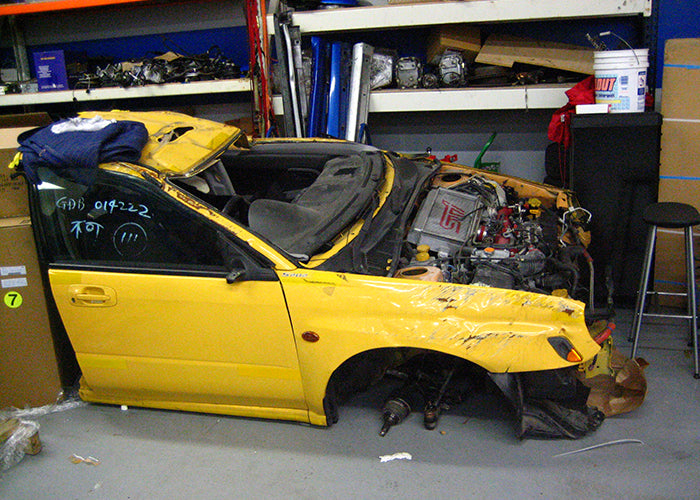Knock, what amount is safe for your Subaru engine?
COBB Tuning has released an excellent article regarding engine knock detection. This should be a mandatory read for all turbo charged Subaru customers, stock or modified. Feel free to send us any questions you may have as well.
BY KYLE ON 04/30/2015
SUBARU KNOCK MONITORING AND DIT DAM STRATEGY CHANGES
Subaru Knock Monitoring
Knock! Knock! Who’s there? It could be nothing at all, but, it may be cause for concern. Knowing the difference can give you peace of mind, or, could be an early indicator of a mechanical issue ticking away on your Subaru. Data logging and monitoring with the Accessport can provide useful data on these knock events. Couple that with some basic knowledge and you’re on your way to quickly and easily diagnosing any knock events at any given time.
First, let’s talk about what exactly “knock” is and how it’s detected by your car’s ECU. Sometimes knock is also called detonation. Detonation is characterized by the air/fuel mixture spontaneously igniting during the compression stroke. The force of this early, unintended explosion is counter to the direction of the piston and results in a sharp increase in cylinder pressure. The increased pressure can exceed the design limits and potentially cause damage. These events typically result in an audible noise that can sound like a “ping” or “knock.” The ECU picks up on this noise with a microphone hard mounted to the engine block and listens for specific frequencies that indicate a knock event. Any number of conditions or factors can induce detonation. The sources are varied but are generally due to increased cylinder pressure, high temperatures, or reductions in effective octane level.
Worried? Don’t be! Detonation events are inevitable and will occur from time to time on any modern vehicle running on pump gas. Your car is built to recognize these events and take the appropriate action to defend against them causing any damage. The Subaru knock detection system tends to err on the side of caution. This makes it common to see “false knock.” False knock occurs when the ECU corrects for a knock event but the noise registered is due to other noises that aren’t necessarily detonation or harmful to the engine. This often happens accelerating from a stop while letting the clutch out, during gear shifts (more so if grunting while shifting), accelerating at low RPM in a high gear, under cruise on the freeway, and during abrupt throttle changes.
Relevant Monitors
There are times when these knock events are bad news. Knowing which parameters to monitor with the Accessport can help determine if that’s the case. Generally, Dynamic Advance Multiplier (DAM), Feedback Knock Correction, and Fine Knock Learning are relevant when monitoring knock.
- DAM represents a global adjustment to ignition timing. If this value is anything less than ideal, it’s a quick indicator something isn’t right (unless immediately following an ECU reset/reflash). On an 02-05 WRX the values will range from 1 to 16, 16 being ideal. On all other Subarus, the value is expressed as a decimal from 0 to 1, the ideal value being 1.
- Feedback Knock Correction is a real-time timing correction the ECU makes based on a perceived noise. The ECU immediately pulls timing (the amount of the Feedback Knock Correction value) and adds timing back (value rises to 0) assuming no further noise is detected.
- Fine Knock Learning represents minor learned corrections based on historical Feedback Knock. If the ECU routinely registers knock in a certain RPM and load range, it will apply timing adjustments which can be seen with this parameter.

In general, we consider Feedback Knock Correction ~-2.5 degrees or less to be “normal” and not of major concern. If DAM is below the ideal value and there are corrections beyond -2.5, this is good reason for further inspection. If these corrections occur during full boost and wide open throttle it is especially concerning.
Poor quality fuel is a common cause for knock. If this is the case, and you’re running an OTS (off the shelf) map, try switching down to a map designed for lower octane fuel. Switching to an “LWG” version OTS map may also help resist knock by lowering boost pressure. Use fuel from top tier retailers in your area to ensure your effective octane is as high as its rating.
Common mechanical causes of knock worthy of inspection are worn MAF or front O2 sensors, boost/intake tract leaks, and excessive blow-by. Definitely be sure to also read the map notes for your vehicle to confirm you have the proper hardware modifications for the map you are running. These can be found on the website by configuring your vehicle and clicking the maps section. Then, select your map and click the “notes available” link. Also, see that you are within the boost range outlined in the map notes. If overboosting is occurring, knock may be more prevalent.
DIT DAM Strategy Changes
The newer DIT car’s (direct injection turbo – 2015+ WRX and 2014+ FXT) strategy is a bit more reactive. This is intentional and is expected since “premium” fuel is not required on the DIT vehicles. The strategy has changed and is comparable to what may have been seen as Fine Knock Learning in the earlier non-DIT cars may now result in a drop in DAM in the DIT cars. It shouldn’t be surprising to see a drop in DAM on the DIT vehicles (as it is on early cars where DAM being less than ideal is an indicator there is an issue) especially running lower octane fuels. How long the DAM takes to return to 1 is not indicative of how serious the knock event was and does not mean the car is still knocking. In order to advance the DAM on DIT vehicles, you have to drive in specific load/RPM ranges without knock. Determining whether there is a a potential issue on a DIT vehicle require considering how low the DAM has dropped and what other knock responses ( Knock Feedback Correction and Fine Knock Learning) look like overall.
Hopefully this post can help ease some concerns when you see those values under the knock parameters. If you think your vehicle might be having some negative issue mentioned above, feel free to contact us and we can review datalogs, help troubleshoot, and answer any questions you might have. Also check out our knowledge base for additional technical information on all things COBB. If you’re interested in learning more about Subaru Knock Monitoring, check out this FAQ.
Subaru knock detection is like using a large net to catch fish. You’ll definitely catch what you want to catch (actual knock) but you will also catch what you don’t want (false knock). If you used a small net, you would get less false knock but might actually miss actual knock. It’s a compromise. Be sure to look at the entire picture when trying to determine whether there is an issue.





